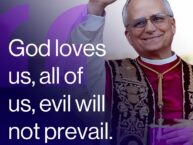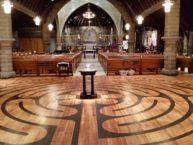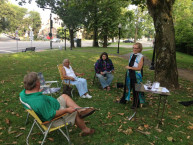![]() May 31, 2015 – Trinity Sunday: May God’s words alone be spoken, may God’s words alone be heard. Amen.
May 31, 2015 – Trinity Sunday: May God’s words alone be spoken, may God’s words alone be heard. Amen.
There is a reason why Trinity Sunday joins the low Sundays after Christmas and Easter as a great day to give the pulpit to a seminarian – because other than singing about “the three that I admire most, God, Son and Holy Ghost, who caught the last train for the coast the day the music died” the doctrine of the Holy Trinity isn’t something most want to sing about. That’s because preaching on the Holy Trinity can sometimes be a theological journey down the proverbial rabbit hole. So, give it to the seminarian – brahahaha!
Unfortunately for me, we don’t have one.
Just after I was made a priest, I was at a coffee hour when I mentioned to a priest friend that I was taking a semester class on the Trinity for fun (and acknowledged I too thought I was out of my mind). He said, “that is one doctrine I wish had remained a mystery!” And, I think that is why most preaching sites say “don’t preach on the trinity…preach on the texts for the day.” And for the most part, I agree with them. Part of the reason we feel that way is that 1+1+1=1 and not 3 sounds a lot like new math that has jumped the cliff. It doesn’t make any sense at all. And, it isn’t even biblical. The trinity as a construct is nowhere in scripture. However, the doctrine is something that I think we do need to talk about, not only because I think we have gotten away from the beauty of it, but also because it is something that people tend to ask clergy about.
It happened just this past week when I was visiting a parishioner in the hospital. As I left the recovery room where she was, I got a call from the hospital chaplain, who just happens to be a friend of mine from seminary. Anyway, she asked if I would visit another patient. He was a Roman Catholic, and gay, and…dying. Over the course of a couple of visits, he and his partner had loads of questions – questions priests and chaplains often get in hospitals – questions like…
“Why would God let this happen?”
“Does heaven exist?”
And so on. But his partner, who leans evangelical, asked me another question – “Is Jesus God?” I got the same question once from a Muslim student at Montclair State during our Interfaith Conversations. She said to all of the Christians in the room “So, you believe Jesus is God, right?” The questions come out of an understanding of Jesus that for the most part, is the result of this doctrine. And when that question comes up, that’s when you really want to pull out the old relationship standby answer of “It’s complicated.” But you see, that’s it – no, not that it’s complicated, but that it’s complicated because it is about relationship.
Huh? I know, sounds a bit like 1 in 3 and 3 and 1 and what?
The doctrine of the trinity is not a description of God, because that is impossible. The doctrine of the trinity is a way of describing relationship – God’s relationship with us. “The Trinity is a statement of how God relates, not how God is. Or perhaps how anyone relates is indeed how one is.”[1] Which is to say that, if we think about it, the trinity is as much about us as it is about God.
Are you having fun yet? ‘cause this Trinity hoe down is just getting started…
Now, about that class I was taking on the trinity… I was reading the assignment for class, when I had this incredible theological epiphany. I thought “We are walking trinities! Within ourselves we embody the doctrine of the Trinity!” Brilliant, I thought! Quite proud of the revelatory insight…that is until I read on a few more pages and realized that Augustine said virtually the same thing several centuries ago – soooo, not so brilliant after all. Still, it is essentially true.
As the ones created in the image of God, we are walking trinities…there is our physical being – the one others see. That is us, but not all of who we are. There is the mind – that powerful organ that can create and imagine what is not yet and bring it into being. And there is the heart, the soul, that guides us intuitively in our lives. All of it is us, but none of it on its own is all of who we are. Or, as the contemporary theologian Frederick Buechner put it, “If the idea of God as both Three and One seems far-fetched and obfuscating, look in the mirror someday. There is (a) the interior life known only to yourself and those you choose to communicate it to ([God]). There is (b) the visible face which in some measure reflects that inner life ([Christ]). And there is (c) the invisible power you have in order to communicate that interior life in such a way that others do not merely know about it, but know it in the sense of its becoming part of who they are (the Holy Spirit). Yet what you are looking at in the mirror is clearly and invisibly the one and only you.”[2]
But more than what Buechner just described, thinking of who we are in the world, who we interact with, gives us a relational picture – we outwardly love our neighbor, inwardly love our selves, and we love God. We cannot claim to love God without doing the other two. And if we do the other two, we inherently love God (with or without realizing it). We are essentially living, breathing, trinities, and it is all steeped in the relationships we have as we go along our life journey.
A pastor once shared that he had an insight about the trinity. He was looking at a stained glass window that had a trinity symbol of interconnecting triangles, that reminded him of an aerial photograph taken of his small farming community… he describes how “the straight and orderly rows of crops in the fields, [were there but also something else. There was] another distinct pattern […] well-worn paths crisscrossing from one farmhouse to another. These paths, worn into the ground by generations of neighbors visiting and helping out in times of need, linked the town, they knit the community together.”
And the pastor thought it was a wonderful depiction of the trinity. As he put it: “God grooves paths in our lives, coming to us at different times and in different forms to address a variety of needs.
God, in three persons, Blessed Trinity, reaches out to us as a strong parental type when we feel small and childlike.
God in three persons, Blessed Trinity, reaches out to us as a forgiving friend in times of loneliness and confusion.
God in three persons, Blessed Trinity, reaches out to us as a sustaining force of inexplicable peace when we are bereft and lost, angry and bitter, hopeless and helpless.
God in three persons, Blessed Trinity, longs to be a palpable presence in our lives, so God, in God’s infinite wisdom, walks a number of paths to reach us.”[3]
I love that imagery…because it is entirely about relationship.
The trinity isn’t some doctrinal formula that the church ought to just bury, it is actually a really beautiful attempt to describe in some way the intricate ways in which God is in relationship with us, and we with God. I think that is why the Celtic knot is often used to describe it – a beautiful pattern that has no beginning or end, with each part distinct, and yet not.
But my favorite depiction of the Trinity is on the cover of our bulletin this morning – take out your bulletins and really look at it. It is the very well known icon done by the Russian Andrei Rublev, who we celebrate as a saint on January 29th. In our “Holy Women, Holy Men” the book of saints for the Episcopal Church, it says “For Andrei, writing an icon was a spiritual exercise. […] Throughout he would repeatedly say the “Jesus Prayer” (“Lord Jesus, Son of God, have mercy on me”). He was creating a window into the Divine which he knew was always before him but which was invisible to the human eye. He knew he was able to create such an image of God because he himself was made in the image of God. His object was to be totally focused on receiving God’s love and loving in return.” And I am grateful for this, and many other icons, as they truly can provide a “window into the Divine” when one looks at them in a contemplative moment. And the doctrine of the trinity is really, in its purpose and effect, an icon – a window into the Divine.
And the reason I love this icon, even having it in my office, is that, if you really look at it, there are three angels, yes, but there is space at the table still! And if you look, you see that these angels seem to be inviting the viewer, inviting you and me, to join them.
THAT is where this whole trinity thing becomes so powerful, because as much as it is our attempt to understand the God that seeks to be in relationship with us – to understand all the ways in which we have experienced God – through creation, through Christ, through the workings of the Spirit – it is also a way in which we remember that we are a part of that infinite relationship of love. We have a seat at the Trinitarian table. And truthfully, we would have too, because the trinity is entirely about how God is in relationship with…us! God had no need to describe herself, but we have need to describe him.
But, as much as it is beautiful, it is also limited, and not universally accepted either. Not all Christian denominations in the West are Trinitarians – the Unitarians for example – nor are the Eastern and Western churches in agreement on how it all works.
And the truth is – it doesn’t matter.
The doctrine itself is not God, and God is not the Trinity.
“When it comes to relating we can’t pin God down to one thing or one way. When we consider one way to view God there is always another way […] But why [this way, why] three, as in the Trinity? Who knows? But we do know that just as we can’t pin God down to one of our simplistic ideas, we also can’t pin her down to three either, or any one of the three.”[4]
God could never be limited to something humans could describe. In as much as poetry describes what it is like to be in love, but is not love itself, the doctrine of the Trinity is the Church’s attempt to describe humanity’s experience of God, but it is not God. If it works for you, fine, if not, that’s okay too.
When we get caught up in the doctrine, and forget what the doctrine attempts to do, then we have indeed relegated the doctrine to irrelevance. Doctrine is only useful if it helps us to be in closer relationship with God. It is useless if it makes that more difficult. This doctrine is no different.
So, don’t get all caught up in the math – 1 in 3 in 1. But do look in the mirror, because we are indeed the very reflection of what the Trinity is, and we are called to live a Trinitarian life – the life in which we love God, love our neighbor and love ourselves. And if we do that, if we live into our Trinitarian calling, we will change the world – no doubt about it.
So, on this Trinity Sunday, don’t work yourself up into a Celtic knot trying to justify the doctrine of the Trinity as being what God is…because it isn’t. God is beyond our limited ability to describe, and we would be arrogant to think otherwise. Instead, think of it as a poetic attempt to describe love – the LOVE that is God – the love that is beyond all measure – the love that is there for each and every one of us whether we believe in it or not.
And then…let it go.
Because poetry is not love, and the trinity is not God. Revel in the love, live in the love, let the words and concepts of the love work into your heart in a never ending cycle, and then continue the poetry – continue to express in your own unique way your relationship with God. Because whatever way works for you is the right way, and the world is in too much need of our Trinitarian work of love to be stymied by doctrine.
In the name of God, Christ, and the Holy Spirit, Amen.
[Sermons as written may not be as delivered on any given Sunday] [1] Bob Eldan. http://preachingtip.com/archives-year-b/pentecost-year-b/trinity-sunday-year-b/ [2] Frederick Buechner. Wishful Thinking: A Theological ABC (New York: Harper & Row, 1973), 93. [3] Adapted from Catherine Dempesy, excerpted from “Miracle and mystery in the three in one and one in three,” a sermon preached on June 4, 2012, at Good Shepherd Episcopal Church, Buffalo, New York. http://goodshepbuf.blogspot.com. Retrieved December 8, 2014. [4] Bob Eldan. http://preachingtip.com/archives-year-b/pentecost-year-b/trinity-sunday-year-b/Rev. Diana L. Wilcox
Christ Church in Bloomfield & Glen Ridge
May 31, 2015
1st Sunday After Pentecost – Trinity Sunday
1st Reading – Isaiah 6:1-8
Psalm 29 or Canticle 2 or 13
2nd Reading – Romans 8:12-17
Gospel – John 3:1-17




